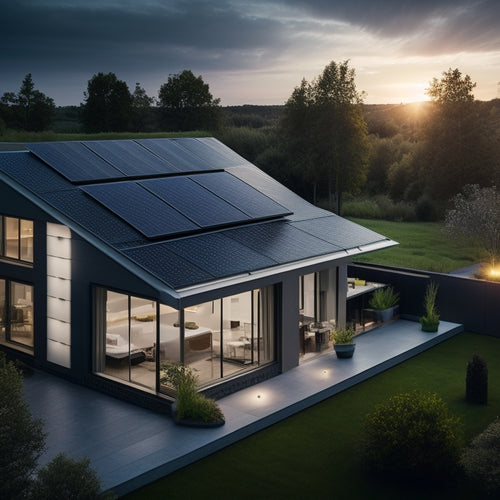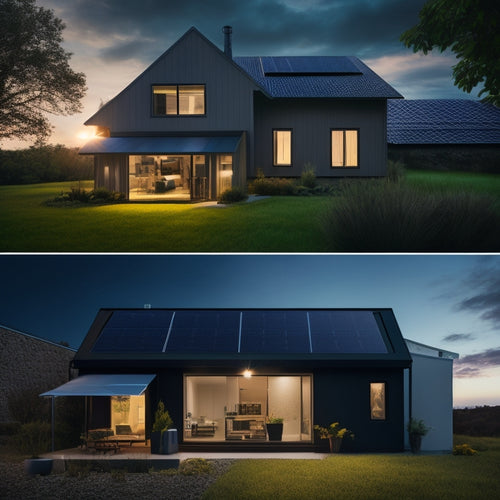
5 Best Energy Solutions for Home Cooling Systems
Share
You're exploring the best energy solutions for your home cooling system, and you're not alone. Traditional air conditioning systems are being replaced by eco-friendly alternatives that minimize carbon footprint and energy costs. Solar power, for instance, is becoming increasingly efficient, allowing you to capture sunlight and store excess energy for nighttime use. Geothermal cooling systems employ natural earth temperatures, while passive ventilation relies on natural airflow and insulation. Additionally, solar thermal systems convert sunlight into thermal energy, and off-grid solar kits offer cost-effective solutions. As you consider these options, you'll find that there are even more innovative solutions available to help you stay cool while going green.
Overview
- Solar-powered cooling systems reduce energy bills by up to 50% and minimize carbon footprint.
- Energy storage systems, like lithium-ion batteries, optimize energy usage and provide nighttime cooling.
- Geothermal cooling systems utilize natural earth temperatures for efficient and eco-friendly cooling.
- Passive ventilation relies on natural airflow and insulation for temperature regulation and reduced energy consumption.
- Solar thermal systems convert sunlight into thermal energy for cooling, providing a sustainable alternative to traditional AC systems.
Harnessing Solar Power Efficiently
In conjunction with advancements in photovoltaic technology, homeowners can now efficiently employ solar power to fuel their cooling systems, thereby reducing their reliance on traditional energy sources.
By integrating energy storage systems that offer high energy density and low maintenance, such as lithium-ion batteries, you can store excess energy generated during the day, allowing you to power your cooling system at night or during periods of low sunlight.
This setup enables you to maximize your energy independence and minimize your carbon footprint.
With the latest photovoltaic technology, you can capture solar power with increased efficiency, making it a viable option for your cooling needs.
Cooling Systems Powered by Sun
With the ability to employ solar power efficiently, you can now power your cooling systems directly from the sun. This is made possible through solar thermal systems, which convert sunlight into thermal energy to cool your home.
Alternatively, you can use photovoltaic panels to generate electricity and power your cooling systems. Many off-grid solar kits, such as those from HQST and Eco-Worthy, offer cost-effective solutions for capturing solar energy scalable for changing energy needs.
These systems can be connected to an inverter, which converts the DC power into AC power, making it compatible with your cooling system. By tapping into the sun's energy, you can greatly reduce your reliance on traditional energy sources, saving you money and reducing your carbon footprint.
With the right system, you can enjoy a cooler home while promoting a sustainable future.
Renewable Energy for Hot Days
As the mercury rises, you're likely to crank up your cooling system to beat the heat, but that doesn't mean you have to rely on traditional energy sources.
Renewable energy solutions can provide a reliable and sustainable way to keep your home cool. One approach is to incorporate energy storage systems, such as batteries, to store excess energy generated by solar panels or wind turbines during cooler periods Energy Efficient Smart Thermostats.
This allows you to optimize energy usage based on schedules and reduce peak energy consumption. This stored energy can then be used to power your cooling system during hot days.
Additionally, incorporating passive design elements, such as large overhangs, shading devices, and insulation, can reduce your cooling load and minimize your reliance on energy-intensive cooling systems.
Solar Cooling Cost Benefits
Since you're considering renewable energy solutions for your home cooling system, it's essential to weigh the cost benefits of solar cooling.
Solar panel installation can greatly reduce your energy bills, especially during peak summer months. With solar cooling, you can utilize the sun's energy to power your cooling system, reducing your reliance on the grid. This not only saves you money but also increases energy efficiency.
In fact, solar cooling can reduce your energy consumption by up to 50%. Additionally, solar panels require minimal maintenance and can last for up to 30 years.
Green Alternatives for Home Cooling
Nearly 80% of American households rely on traditional air conditioning systems, which contribute considerably to greenhouse gas emissions and climate change.
You have the power to break free from this trend and opt for green alternatives for home cooling. Geothermal cooling systems, for instance, use the earth's natural temperature to cool your home, reducing your carbon footprint.
Another option is passive ventilation, which utilizes natural airflow and insulation to regulate your home's temperature.
By incorporating these eco-friendly solutions, you'll not only reduce your energy consumption but also create a healthier living space.
Take control of your cooling system and join the movement towards a more sustainable future.
Frequently Asked Questions
Can I Install Solar Cooling Systems in Apartments or Rented Homes?
You can investigate solar cooling systems for your apartment or rented home, but first, assess the solar panel feasibility and apartment solar options available, considering factors like roof access, lease agreements, and local regulations.
Do Solar Cooling Systems Require Frequent Maintenance Checks?
As you bask in the cool comfort of your solar-powered oasis, remember that regular maintenance checks are vital to guarantee maximum solar panel efficiency, just like a gardener tends to their lush greenery, following best practices to prevent dust and debris from hindering performance.
Are Solar Cooling Systems Compatible With Existing HVAC Systems?
You'll find that solar cooling systems seamlessly integrate with existing HVAC systems through solar panel integration, allowing you to capitalize on energy efficiency benefits while maintaining your current setup's functionality.
Can I Use Solar Cooling Systems for Heating in Winter?
You can repurpose your solar cooling system for solar heating in winter, leveraging its energy efficiency to warm your home, but you'll need to integrate a heat exchanger and a reversing valve to optimize performance.
Are There Government Incentives for Solar Cooling System Installations?
You'll be pleased to know that yes, you can benefit from government incentive programs and tax credits when installing solar cooling systems, which can considerably offset the upfront costs, giving you more freedom to invest in your sustainable lifestyle.
Ready to Buy
As you step into your cool, sun-lit home, the sweltering heat of the summer sun fades away. You've utilized the power of the sun to cool your space, and it feels incredible. With solar cooling systems, you're not only beating the heat but also reducing your carbon footprint. Imagine the satisfaction of knowing your home is a haven of comfort, powered by nature's own energy source. The future of home cooling has never looked brighter – or cooler.
Related Posts
-

Why Outdoor Solar Lighting Systems Are Sustainable
Outdoor solar lighting systems are sustainable because they utilize renewable energy, drastically reducing your carbo...
-

Home Solar Battery
You're opting for a home solar battery that allows you to utilize the power of the sun during the day and use it at n...
-

Cost of Home Solar Battery
You're looking to invest in a home solar battery to reduce your grid reliance, but you're curious about the cost. The...


